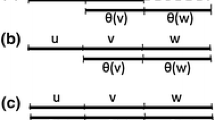Abstract
The absence of the ability to form a specified set of bonds in a collection of DNA strands is crucial in the design of experiments encoding algorithmic problems as single- or double-stranded DNA. Recently, the specification of the bonding types to be avoided has been formalized by defining bond-free properties. Bond-free properties generalize several bonding properties which have been studied in the context of DNA computing. In this paper, we consider a bond-free property as defining a class of languages. We study the properties of these classes of languages. We develop new unary operators on languages for characterizing bond-free properties exactly, using familiar code-theoretic equations. These new operators provide a new characterization of maximal bond-free properties as well. We also focus on relationships to classes of languages from the theory of codes.
Similar content being viewed by others
References
Adleman L (1994) Molecular computation of solutions to combinatorial problems. Science 266:1021–1024
Berstel J and Perrin D (1996) Theory of Codes. Available at http://www-igm.univ-mlv.fr/%7Eberstel/LivreCodes/Codes.html
Domaratzki M (2004a) Deletion along trajectories. Theoretical Computer Science 320(2–3):293–313
Domaratzki M (2004b) Trajectory-Based Codes. Acta Informatica 40(6–7):491–527
Domaratzki M (2004c) Trajectory-Based Embedding Relations. Fundamenta Informatica 59(4):349–363
Domaratzki M (2005) More Words on Trajectories. Bulletin of the European Association of Theoretical Computer Science 86:107–145
Domaratzki M and Salomaa K (2005) Codes defined by multiple sets of trajectories. In: Esik Z and Fulop Z (eds) Automata and Formal Languages (AFL’05), pp. 97–111, Theoretical Computer Science (to appear)
Ginsburg S (1966) The Mathematical Theory of Context-Free Languages. McGraw-Hill
Hopcroft JE and Ullman JD (1979) Introduction to Automata Theory, Languages, and Computation. Addison-Wesley
Hunt H, Rosenkrantz D (1977) On equivalence and containment problems for formal languages. Journal of the Association for Computing Machinery 24(3):387–396
Hussini S, Kari L, Konstantinidis S (2002) Coding properties of DNA languages. Theoretical Computer Science 290(3):1557–1579
Jürgensen H and Konstantinidis S (1997) Codes. In: Rozenberg G and Salomaa A (eds) Handbook of Formal Languages, Springer pp. 511–600
Kadrie A, Dare V, Thomas D, Subramanian K (2001) Algebraic Properties of the shuffle over ω-trajectories. Information Processing Letters 80(3):139–144
Kari L, Kitto R and Thierrin G (2003a) Codes, involutions and DNA encoding. In: Brauer W et al. (eds) Vol. 2300 of LNCS, pp. 376–393
Kari L and Sosík P (2003) Language deletions on trajectories. Technical Report 606, Computer Science Department, University of Western Ontario
Kari L, Sosík P (2005) Aspects of shuffle and deletion on trajectories. Theoretical Computer Science 332(1–3):47–61
Kari L, Konstantinidis S (2005) Language equations, maximality and error-detection. Journal of Computer and System Sciences 70:157–178
Kari L, Konstantinidis S, Losseva E, Wozniak G (2003b) Sticky-free and overhang-free DNA languages. Acta Informatica 40:119–157
Kari L, Konstantinidis S, Sosík P (2005a) Bond-free Languages: Formalisms, Maximality and Construction Methods. International Journal of Foundations of Computer Sciences 16:1039–1070
Kari L, Konstantinidis S, Sosík P (2005b) On properties of bond-free DNA languages. Theoretical Computer Science 334:131–159
Mateescu A, Rozenberg G, Salomaa A (1998) Shuffle on trajectories: Syntactic constraints. Theoretical Computer Science 197:1–56
Nowotka D and Harju T (2004) Periodicity and unbordered words. In: Diekert V and Habib M (eds) STACS (Montpellier, 2004), Vol. 2996 of LNCS, pp. 294–304
Shyr H (2001) Free Monoids and Languages. Hon Min Book Company, Taichung, Taiwan
Yu S (1997) Regular languages. In: Rozenberg G and Salomaa A (eds) Handbook of Formal Languages, Springer pp. 41–110.
Acknowledgements
Many thanks to the anonymous referees for their suggestions which improved the presentation of this article.
Author information
Authors and Affiliations
Corresponding author
Additional information
Research supported in part by a grant from NSERC.
Rights and permissions
About this article
Cite this article
Domaratzki, M. Bond-free DNA language classes. Nat Comput 6, 371–402 (2007). https://doi.org/10.1007/s11047-006-9022-8
Received:
Accepted:
Published:
Issue Date:
DOI: https://doi.org/10.1007/s11047-006-9022-8




